A radio announcement, a Facebook post, and a leap of faith led to a life-saving connection between two strangers. When civil engineer Edmund “Ed” Martin from Rochester, New York, heard a radio story about a man in the community in need of a living liver donation, he felt called to help, not knowing his gift would save the life of a young man with alpha-1 antitrypsin deficiency (Alpha-1). This is the story of how faith, fitness, and one incredible act of generosity brought two families together and gave Alpha Zachary “Zach” Grey a second chance at life.
Today, both men are thriving and sharing their story to inspire hope and awareness for the Alpha-1 community.
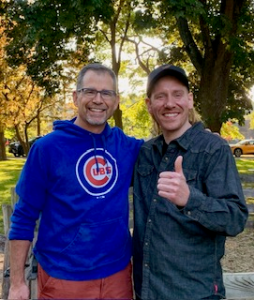
Edmund “Ed” Martin (left) and Zachary “Zach” Grey (left).
When 56-year-old Ed, an Army veteran and civil engineer from Rochester, New York, heard a radio announcement in 2019 about living liver donation, he stopped mid-conversation at work.
“I looked up at my coworker and said, ‘Did he just say living donor?’” he recalls. “I didn’t even know that was possible, except for maybe kidneys. But something in my spirit said, ‘You need to look into this.’”
A living donor transplant, in which a healthy person donates part of their liver, is relatively rare, making up about 6% of all liver transplants performed each year.
“I always had the box checked on my driver’s license,” he says, “but I never thought about living donation. When I heard that radio segment, I just knew I had to make the call.”
He didn’t tell anyone in his personal life his plans, but started researching the process and exploring whether or not he would be eligible to make such a donation. That one moment would lead Ed to an extraordinary act of generosity, and to a lifelong friendship with a young man named Zach, who was fighting for his life as a result of alpha-1 antitrypsin deficiency (Alpha-1), a rare genetic condition that can cause serious liver and lung disease.
Before their paths crossed, Ed and Zach couldn’t have been more different.
Ed, a devout Christian, civil engineer, husband, and father of two grown sons, built a life of service — first in the Army, then through his decades-long career building roads and infrastructure around Rochester. He had taken up long-distance running the year prior, logging more than 2,400 miles in 2019, and was in the best shape of his life. At the time, he didn’t know that this discipline was preparing him for one of his biggest physical challenges yet.
Zach, meanwhile, led a fast-paced life as a professional musician. In his late twenties, he spent years touring across the U.S. and Canada with his band. “It was a dream,” Zach says. “I was healthy, active, playing shows every night.”
When he wasn’t touring, he worked in restaurants around Rochester, saving up for travel and recording projects.
“I’d always been healthy — soccer, football, skateboarding as a kid,” he says. “No one saw this coming.”
Everything changed in early 2019, when his ankle started to swell. After the ankle swelling came bloodwork that showed abnormal liver numbers. He brushed it off, until a simple fall out of bed resulted in a broken arm.
“I thought it was the dumbest injury ever,” Zach jokes. “But when the X-rays came back, they said my bones were like someone post-menopausal. Turns out my liver wasn’t processing vitamin D or calcium right, so my bones were brittle. That’s when they started asking bigger questions.”
After a round of tests, Zach was diagnosed with Alpha-1, and learned that the condition had silently wreaked havoc on his liver. “I’d never even heard of it,” he says. “But by then, my liver was already in bad shape.”
By September 2019, things spiraled. “I went to work one day and told my boss I just didn’t feel right. By the next morning, I’d sweated through my sheets. When I got to the hospital, they told me I had sepsis from an infection in my ascites fluid.”
From there, Zach’s life became a cycle of hospitalizations. Ten liters of fluid was drained from his abdomen every ten days, he had dangerously low sodium levels, and he spent managing symptoms of end-stage liver disease.
His MELD (Model for End-Stage Liver Disease) score, which is used to determine the severity of one’s liver disease and transplant need, climbed to 34. The higher one’s MELD score, the more severe one’s liver failure risk — 40 is the scale’s maximum score. Zach’s doctors started discussing the need for a liver transplant.
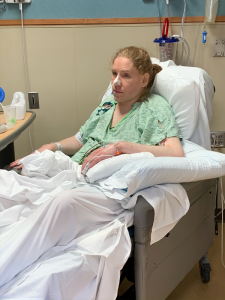
Zach at Strong Memorial Hospital in Rochester, New York, before his transplant.
“I was so tired,” Zach remembers. “I just wanted to feel normal again.”
With Zach’s health deteriorating, his liver transplant coordinator at Strong Memorial Hospital in Rochester encouraged his family to share his story on Facebook to seek a living liver donor.
“I told my mom it was ridiculous,” Zach admits. “But she said, ‘What do we have to lose?’ So we made a post around Thanksgiving of 2019.”

Zach and his mother in the hospital before his transplant.
That post quickly spread across upstate New York. Within days, there were thousands of shares, messages of support, and potential donor inquiries. And one of the people who heard about it wasn’t even on social media himself.
While Ed was still thinking about the radio announcement he had heard earlier in the day, that very night, his wife mentioned she’d seen a Facebook post about a young man named Zach who needed a liver donor.
“She said, ‘That sounds like something you would do,’” Ed recalls. “I told her, ‘You need to sit down, you’re not going to believe this.’”
It wasn’t the same patient mentioned on the radio, but when Ed went through his initial screening, he was offered the chance to be tested for both men. One was an elderly Vietnam veteran; the other, 30-year-old Zach.
Testing showed he was a perfect match for Zach — they were even similar sizes, both men were over 6 feet tall and Ed was told that he had an unusually large liver, something that would bode well for the transplant. His overall excellent health also made him an ideal candidate for the complex surgery.
“The doctors told me I was in incredible shape,” Ed remembers. “They could barely get my heart rate up during the stress test. I honestly think God had been preparing me physically for this.”
Zach’s living donor had been found.
“It was wild,” Zach says “It really felt like something bigger was happening.”
While living donors can choose to remain anonymous, after encouragement from his wife, Ed decided he would like to meet Zach, and Zach decided the same. The two met with their families, outdoors at the Rochester Zoo during the early stages of the COVID-19 pandemic, where Zach broke the ice immediately.
“He walked up, looked at his stomach, looked at mine, and said, ‘I think it’ll fit,’” Ed recalls, smiling. “That one line put me completely at ease.”
“We were both masked, and I was immune-compromised, so we kept our distance,” Zach says. “But I could tell right away — he was the real deal. Just a genuinely good person.”
As it turned out, the two families already shared a surprising connection: Zach’s mother had been Ed’s oldest son’s kindergarten teacher and she and Ed’s wife had taught at the same school.
“It was wild,” Zach says. “It really felt like everything was meant to happen exactly this way.”
When the call finally came, both men were ready, but the world was not.
Their first surgery date, in April 2020, was canceled because of the COVID-19 shutdown when all surgeries considered “elective” were postponed. “I said, ‘How is this elective?’” Ed remembers. “But they couldn’t take the risk then.”
The procedure was rescheduled for August 20, 2020 -– a date that turned out to be Zach’s parents’ wedding anniversary, the day before his mother’s birthday, and around the same time as his late father’s passing the year before. “It felt like a sign,” Zach says. “Like everything was lining up the way it was supposed to.”
With the new date scheduled, another obstacle appeared: a kidney specialist wasn’t satisfied with Ed’s lab results. Ed pushed for further testing, which ultimately cleared him. “That was the only hiccup in the entire process,” Ed says.
The surgery lasted nearly 16 hours. When Ed woke up, he heard a familiar voice — his post-op nurse happened to be a friend from church. “She said, ‘I had no idea you were the donor! If you’re not comfortable, I can switch.’” Ed remembers. “I said, ‘No, it’s an answer to prayer.’ It was another one of those God-moments.”
Both surgeries were a success. The two-thirds of Ed’s liver transplanted into Zach began regenerating immediately, as did the portion that remained in Ed’s body.
“I actually felt great when I woke up,” Zach says. “Probably adrenaline, but it was incredible. I just kept asking for water.”
When Ed visited Zach the next day, he was stunned by how good his recipient looked. “He had great color,” Ed says, smiling. “Meanwhile, I was yellow and jaundiced. We joked about it.”
“Half my face was still swollen, so I had this half-smile going on,” Zach remembers. “But it was incredible to see him standing there, healing right alongside me.”
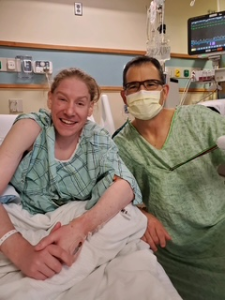
Ed visiting Zach in the hospital after their successful surgeries.
Ed’s recovery was remarkably smooth. “I felt no pain. I was walking laps around the nurses’ station the next morning,” he says. “The staff couldn’t believe it.”
Ed is quick to deflect any praise. “People thank me, and it makes me uncomfortable,” he admits. “I had the easiest job of everyone involved, I just took a long nap. My wife, the doctors, the nurses, Zach — they all had the hard part.”
Today, Ed describes the experience as one of the greatest privileges of his life. “Outside of my boys being born,” he says quietly, “this is the most profound thing I’ve ever been part of.”
And for Zach, that “long nap” truly became a lifeline.
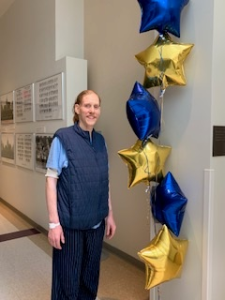
Zach before officially being discharged from the hospital.
Zach’s recovery took longer, but his improvement was steady. Within weeks, his energy returned, his fluid buildup disappeared, and his lab numbers began to normalize. With social distancing still in effect, Zach spent most of his recovery time at his mother’s house, bonding with his newborn nephew. “He’s five now and in kindergarten,” Zach says proudly. “He still thinks I’m the coolest uncle ever.”

Zach holding his baby nephew.
Since the procedure, the two men have stayed close, celebrating their ‘liver-versary’ every August 20th, sometimes over breakfast, sometimes ice cream, always with their families in tow.
Ed and Zach celebrating throughout the years:


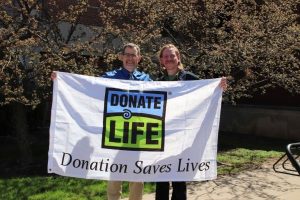
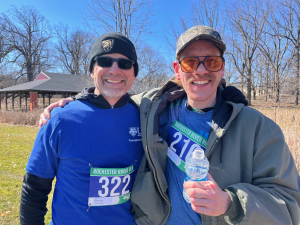
These days, Zach is thriving, and giving back in an extraordinary way.
After recovering, he took part in RochesterWorks, a local non-profit program that offers job training and placement, and now works at Strong Memorial Hospital — the very same hospital where he received his transplant.
“I told the job counselor I didn’t want to go back to that hospital,” he jokes. “But now I’m there every day as a pharmacy technician, preparing IV medications for patients. It’s surreal. In 2020, I was the one getting those meds, and now I’m the one making them.”
For Ed, who still works as a civil engineer and mentors other young engineers, the experience deepened his faith and sense of purpose.
Both men agree that sharing their story is about more than gratitude, it’s about awareness.
For Zach, it’s a message to others with Alpha-1 who might be feeling scared or hopeless.
“Don’t give up,” he says. “Trust your team. Trust your support system. I was really, really sick. But life after transplant is possible — and it can be beautiful.”
Ed encourages anyone healthy enough to consider living donation.
“If you feel that tug, start the process,” he says. “You can back out at any time. But you might just save someone’s life. Everything lined up perfectly for us. It wasn’t luck — it was purpose.”
And for Zach, that purpose means everything. “Thanks to living donation,” he says, “I get to still be here – making music, working at the hospital, and living life. That’s the biggest gift there is.”
About Alpha-1 and Living Liver Donation
Alpha-1 antitrypsin deficiency (Alpha-1) is a genetic disorder that can lead to serious liver and lung disease. For those with severe liver involvement, a transplant can be life-saving — and a living donor transplant, in which a healthy person donates part of their liver, is sometimes an option.
Because the liver regenerates, both the donor’s and recipient’s livers typically grow back to near full size within months. Living donation can shorten wait times and save lives for those with Alpha-1 who might otherwise wait years for a deceased donor organ.
Successful liver transplantation can provide decades of healthy life. Plus, the new, healthy liver will produce normal quantities of normal AAT — essentially, although the recipient’s genetics remain the same, liver transplantation cures Alpha-1.
To learn more about living organ donation, visit: https://www.organdonor.gov/learn/process/living-donation
To learn more about Alpha-1, visit AlphaNet’s Big Fat Reference Guide (BFRG): https://www.bfrg.alphanet.org
